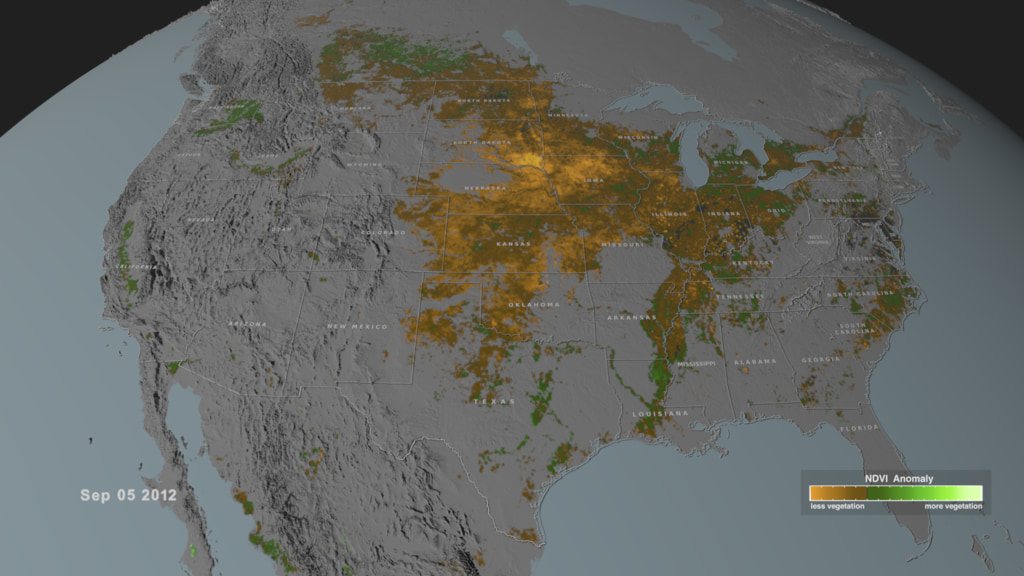A Global view of Normalized Difference Vegetation Index (NDVI) Anomaly in crop-growing regions from 2000 to 2021
This visualization shows the NDVI anomaly from the year 2000 to 2021 in areas where maize, rice, soybeans, spring wheat or winter wheat are grown. Green colors indicate more than average vegetatation while orange colors indicate less productive areas.
Coming soon to our YouTube channel.
Conditions in certain regions of the globe are suitable for growing particular crops but weather can alter the growing conditions in those regions throughout the year. Satellite data can gauge the health of plants, which is a good indicator of crop productivity. The satellite imagery used in this visualization shows changes in vegetation in regions where maize, rice, soybeans, spring wheat and winter wheat are grown.
The Normalized Difference Vegetation Index (NDVI) measures how dense and green plant leaves are which suggests overall vegetative health. Scientists calculate average NDVI values over a span of years to find out what is normal at each time of year. They then compare the current NDVI value for each day of year to the average computed over the set of base years to determine if the areas are more or less productive than the average. This comparison, called the NDVI Anomaly, is used in this visualization showing the changes in global crop production between 2000 and 2021. The NDVI anomaly images are useful as a measure of drought when compared to 'normal' plant health. In this visualization, regions where crops are more productive than average are shown by shades of green where the brightest colors are the most productive. Areas of drought are shown in shades of orange, with the most severe drought being the brightest orange/yellow.
This data was measured by the vegetation instrument Moderate Resolution Imaging Spectroradiometer (MODIS) on NASA’s Terra satellite. However, this instrument is not able to see the surface through clouds so there are regions where no data is collected on cloudy days. In these regions, the most recent prior days value is used up to 10 days before. Areas without data for ten or more days are designated as having no data. Areas with no data or areas that have a value close to average are shown in dark grey. Time periods when no data is available globally have been skipped in this visualization.

An image showing the regions where maize is grown

An image showing the regions where rice is grown

An image showing the regions where soybeans are grown

An image showing the regions where spring wheat is grown

An image showing regions where winter wheat is grown
Credits
Please give credit for this item to:
NASA's Scientific Visualization Studio
-
Visualizers
-
Cindy Starr
(Global Science and Technology, Inc.)
- Lori Perkins (NASA/GSFC)
-
Cindy Starr
(Global Science and Technology, Inc.)
-
Scientists
- Inbal Becker Reshef (University of Maryland)
- Michael Humber (University of Maryland)
-
Communications specialist
-
Producers
- Katie Jepson (KBR Wyle Services, LLC)
- Kathryn Mersmann (KBR Wyle Services, LLC)
- LK Ward (KBR Wyle Services, LLC)
-
Project support
- Eric Sokolowsky (Global Science and Technology, Inc.)
- Kaushal Patel (SSAI)
-
Technical support
- Laurence Schuler (ADNET Systems, Inc.)
- Ian Jones (ADNET Systems, Inc.)
Datasets used
-
Normalized Difference Vegetation Index (NDVI) (Normalized Difference Vegetation Index (NDVI)) [Terra: MODIS]
ID: 1122
Note: While we identify the data sets used on this page, we do not store any further details, nor the data sets themselves on our site.
Release date
This page was originally published on Monday, August 9, 2021.
This page was last updated on Monday, January 6, 2025 at 12:18 AM EST.


![Music: Building Ideas [Instrumental] by Todd James Carlin BakerComplete transcript available.](/vis/a010000/a013800/a013894/GLAM_thumbnail.png)